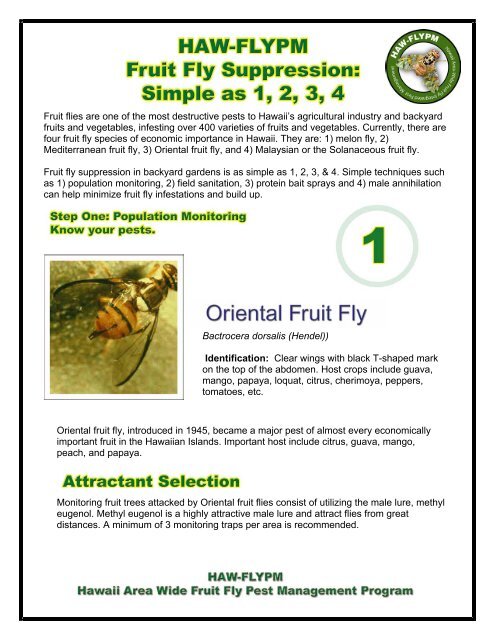Oriental fruit Fly
Oriental fruit Fly
Oriental fruit Fly
Create successful ePaper yourself
Turn your PDF publications into a flip-book with our unique Google optimized e-Paper software.
Fruit flies are one of the most destructive pests to Hawaii’s agricultural industry and backyard<br />
<strong>fruit</strong>s and vegetables, infesting over 400 varieties of <strong>fruit</strong>s and vegetables. Currently, there are<br />
four <strong>fruit</strong> fly species of economic importance in Hawaii. They are: 1) melon fly, 2)<br />
Mediterranean <strong>fruit</strong> fly, 3) <strong>Oriental</strong> <strong>fruit</strong> fly, and 4) Malaysian or the Solanaceous <strong>fruit</strong> fly.<br />
Fruit fly suppression in backyard gardens is as simple as 1, 2, 3, & 4. Simple techniques such<br />
as 1) population monitoring, 2) field sanitation, 3) protein bait sprays and 4) male annihilation<br />
can help minimize <strong>fruit</strong> fly infestations and build up.<br />
Bactrocera dorsalis (Hendel))<br />
Identification: Clear wings with black T-shaped mark<br />
on the top of the abdomen. Host crops include guava,<br />
mango, papaya, loquat, citrus, cherimoya, peppers,<br />
tomatoes, etc.<br />
<strong>Oriental</strong> <strong>fruit</strong> fly, introduced in 1945, became a major pest of almost every economically<br />
important <strong>fruit</strong> in the Hawaiian Islands. Important host include citrus, guava, mango,<br />
peach, and papaya.<br />
Monitoring <strong>fruit</strong> trees attacked by <strong>Oriental</strong> <strong>fruit</strong> flies consist of utilizing the male lure, methyl<br />
eugenol. Methyl eugenol is a highly attractive male lure and attract flies from great<br />
distances. A minimum of 3 monitoring traps per area is recommended.
• Plastic container with cap, cover or lid<br />
• Flexible & strong metal wire<br />
• Plastic <strong>fruit</strong> fly specific male lure: Methyl eugenol<br />
• Sticky cards or soapy water<br />
(Fig.1)<br />
(Fig.2)<br />
• Create hole at the top or side of bottle. String wire through (Fig.1).<br />
• Conform wire to make a hook like structure for hanging.<br />
• Add an inner hook for male lure placement (Fig 2).<br />
• Affix wire to bottle.<br />
• Utilize the plastic <strong>fruit</strong> fly specific male lure: Methyl eugenol (Fig 3).<br />
• <strong>Oriental</strong> Fruit flies tend to feed on the male lure, methyl eugenol (Fig.4)<br />
• To protect lures, place window screen over wicks to minimize feeding.<br />
• Make medium size holes on the side of the bottle / container.<br />
This enables the fly to enter the container (Fig. 5).<br />
• Insert a sticky card OR use soapy water on the bottom of trap.<br />
SOAPY WATER: (Fig. 6)<br />
Place soapy water in the bottom of plastic bottle.<br />
Flies will drown in the solution. Dispose of dead flies<br />
on the bottom of the trap monthly and replace<br />
soapy water solution, as needed.<br />
STICKY CARD: (Fig. 7)<br />
Flies that are attracted into the bottle by the male<br />
lure will stick onto the sticky card and die. Replace card<br />
every month.<br />
• Replace plastic lures every 3-4 months.<br />
• Hang traps in or around <strong>fruit</strong> trees i.e. citrus, mango, guava.<br />
• Fruit flies caught in traps should be counted, recorded and removed.<br />
• Replace soapy water /sticky cards as they become filled with <strong>fruit</strong> flies.<br />
(Fig.3)<br />
(Fig.4)<br />
(Fig.5)<br />
(Fig.6)<br />
(Fig.7)




